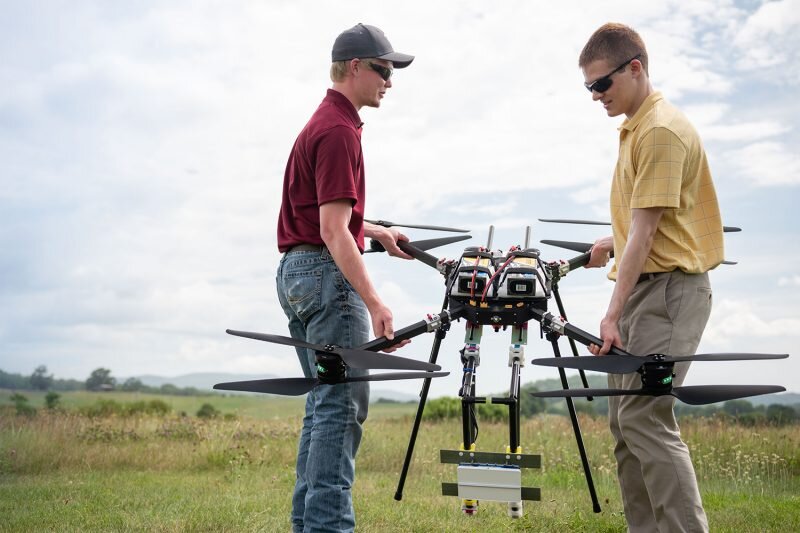
In the drone industry, it's called "the detect and avoid problem." Enabling drones to sense nearby aircraft and move out of their way has long been one of the most formidable barriers between a technology narrowly confined to specialized applications and one reaching its potential.
"There are countless beneficial applications for drones," said Mark Blanks, the director of the Virginia Tech Mid-Atlantic Aviation Partnership (MAAP). "But in order for them to be practical and scalable, the industry needs technology that's proven it can enable much greater autonomy, especially in detect and avoid."
MAAP is one of seven test sites designated by the FAA to lead the research supporting the integration of drones into the national airspace. Now they've moved the industry closer to a solution for one of its key challenges with a real-world evaluation of an "end-to-end" detect and avoid system: A set of components that allows a drone not only to detect intruders, but to maneuver autonomously out of the way.
The tests were the culmination of a year-long project called RAAVIN, the latest installment in a long-running collaboration between MAAP and NASA investigating potential solutions to detect and avoid.
One reason detect-and-avoid technology is so crucial for the industry is because it can enable longer-distance flights by releasing a drone from its dependence on the eyesight of its ground-based pilot or a nearby visual observer.
Federal law requires all aircraft to have a way to see and avoid other air traffic. For drones to share the airspace safely, they need to be able to meet this requirement. But while the pilot of a manned aircraft can always scan the airspace from the cockpit, the pilot of a drone loses the ability to ensure the airspace is clear the second the drone flies beyond the point where they can visually scan its surroundings.
That's why the FAA's regulations for commercial drone flights stipulate that the drone must stay within its operator's visual line of sight.
The line-of-sight requirement can be waived if the operator can make a case that the specific operation they're proposing can be done safely. But for drones to reach their economic potential those longer flights will need to be routine, not authorized by individual approvals meted out case by case. That won't happen until researchers can come up with a technology, or a set of technologies, that can replicate the ability of a pilot's eyes to scan the sky.
The leading contenders are optical sensors, acoustic sensors, and radar. But sensing is only a third of the puzzle: the system also has to be able to detect unsafe conditions and direct an appropriate avoidance maneuver.
"We're just now getting to the point where these three components—the detect, alert, and avoid piece—are mature enough to be able to assemble them and get good results from the test," said John Coggin, MAAP's chief engineer, who oversaw the RAAVIN project.
To put one promising system through its paces, the research team outfitted a multirotor drone with a state-of-the art Echodyne radar and a NASA detect-and-avoid software system called ICAROUS.
At a rural test facility near Blacksburg, the team executed a series of potential encounter scenarios between the drone and "intruder" aircraft—another drone, operated by NASA, and a Cessna flown by pilots from Liberty University—in which the intruder appeared to be on a path that would take it too close to the drone.
If the radar and navigation algorithms worked together successfully, the drone would maneuver out of the way to preserve a hockey-puck-shaped buffer zone defining a safe distance between itself and other aircraft.
"That first time that we allowed it to actually run through its autonomous maneuver, I was thrilled," Coggin recalled. "The NASA ICAROUS software commanded a gentle maneuver to stay clear of the manned aircraft and the drone behaved as it was supposed to."
"This was one of the most exciting moments I've experienced at the test site, to witness an autonomous system replace what the pilot does when it comes to sense and avoid," he said.
Lou Glaab, the assistant branch head of the aeronautics systems engineering branch at NASA's Langley Research Center and NASA's principal investigator on the project, addded that "RAAVIN was a great collaborative effort between MAAP and NASA and significantly moved the state of the art in autonomous sense and avoid technology with results that can be leveraged for future development and testing."
When the team processed the data afterward, measuring the closest point of approach between each intruder and the drone and comparing the coordinates the radar reported for the intruders' location to their own GPS records, it reinforced the test's success.
"It's hard to tell in the field exactly how well it's working," said Andrew Kriz, the MAAP engineer who led the hands-on work for the project. "When we started pulling the data afterwards and animating it, we could see that you had two aircraft coming head on and when the radar saw the traffic it executed a nice gradual right turn and got out of the way. It's really neat to actually see it work."
The testing also shed light on some of the challenges detect-and-avoid technology encounters when it's used in a complex real-world environment, and opportunities for further work—for example, improving the ability of the integrated system to identify and reject false targets.
Kriz, Coggin, and the MAAP team are continuing to work with NASA to tackle those challenges, optimizing the capability and reliability of the radar and algorithms to move closer to a practical solution for detect and avoid.
Citation: Testing shows drones can use autonomous technology to dodge other air traffic (2020, February 6) retrieved 6 February 2020 from https://techxplore.com/news/2020-02-drones-autonomous-technology-dodge-air.html
This document is subject to copyright. Apart from any fair dealing for the purpose of private study or research, no part may be reproduced without the written permission. The content is provided for information purposes only.
